dead battery CADILLAC CATERA 1997 1.G Owners Manual
[x] Cancel search | Manufacturer: CADILLAC, Model Year: 1997, Model line: CATERA, Model: CADILLAC CATERA 1997 1.GPages: 338, PDF Size: 18.02 MB
Page 117 of 338
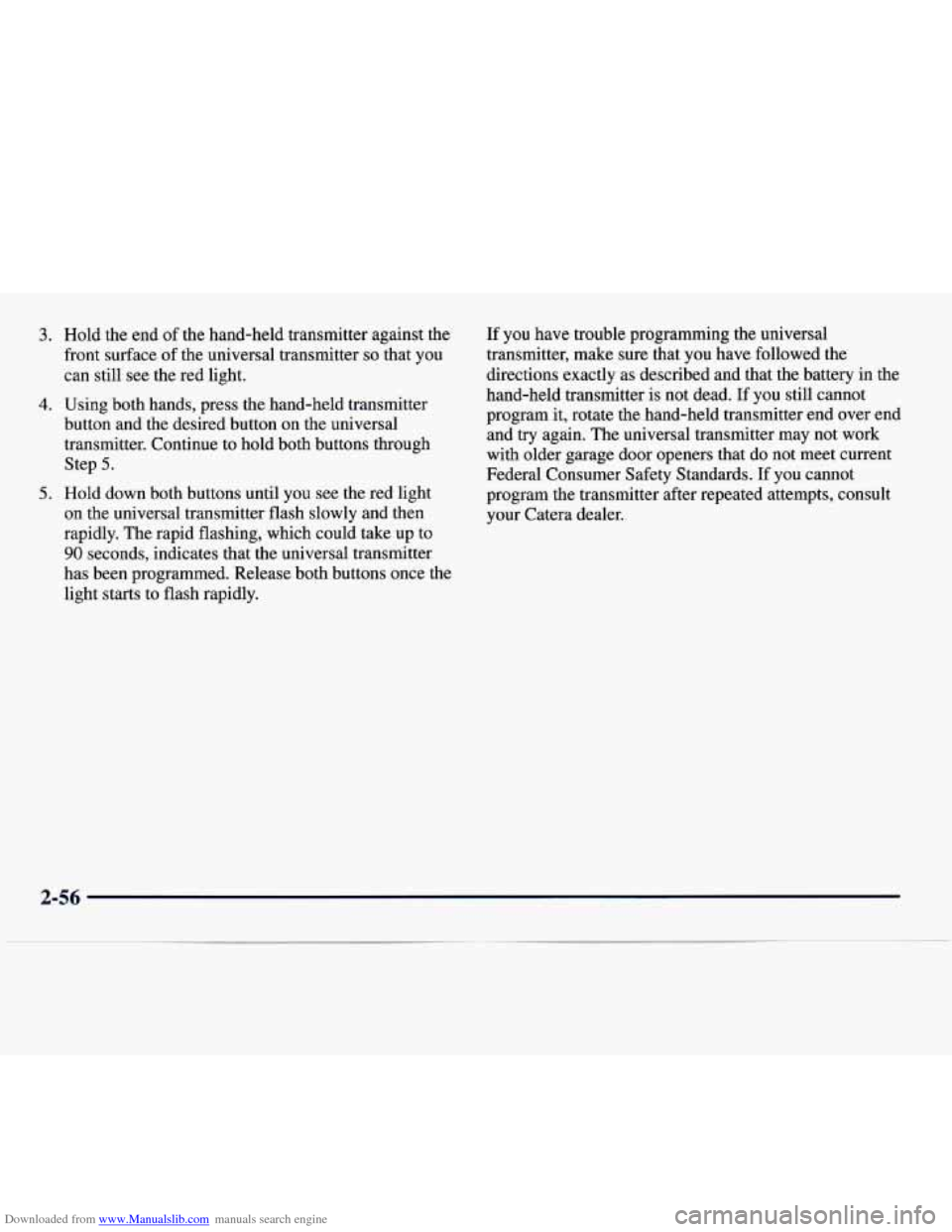
Downloaded from www.Manualslib.com manuals search engine 3. Hold the end of the hand-held transmitter against the
front surface of the universal transmitter
so that you
can still see the red light.
4. Using both hands, press the hand-held transmitter
button and the desired button on the universal
transmitter. Continue to hold both buttons through
Step
5.
5. Hold down both buttons until you see the red light
on the universal transmitter flash slowly and then
rapidly. The rapid flashing, which could take up to
90 seconds, indicates that the universal transmitter
has been programmed. Release both buttons once the
light starts to flash rapidly.
If you have trouble programming the universal
transmitter, make sure that you have followed the
directions exactly as described and that the battery in the
hand-held transmitter is not dead. If you still cannot
program it, rotate the hand-held transmitter end over end
and try again. The universal transmitter may not work
with older garage door openers that do not meet current
Federal Consumer Safety Standards. If you cannot
program the transmitter after repeated attempts, consult
your Catera dealer.
2-56
Page 196 of 338
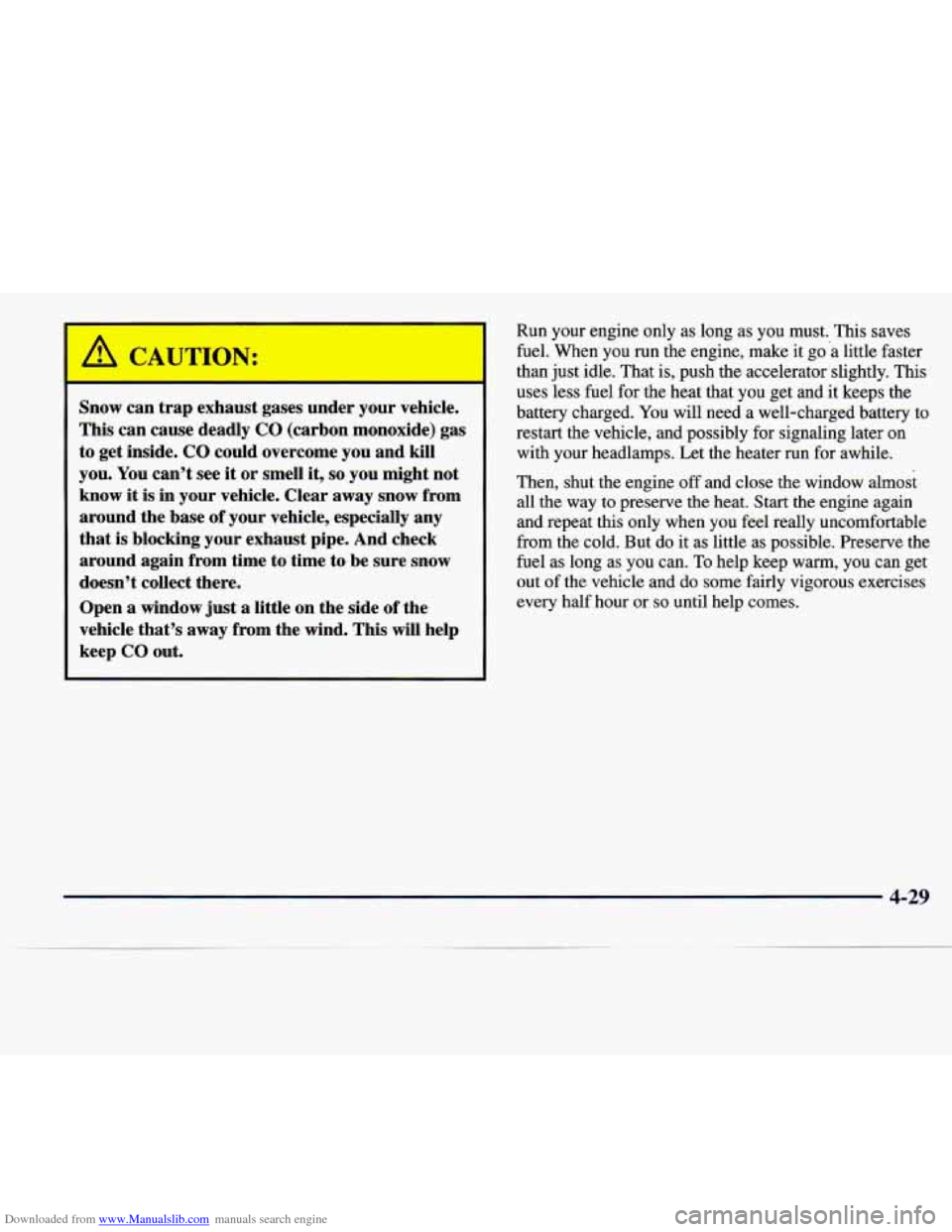
Downloaded from www.Manualslib.com manuals search engine A CAUTION:
Snow can trap exhaust gases under your vehicle.
This can cause deadly
CO (carbon monoxide) gas
to get inside.
CO could overcome you and kill
you. You can’t see it or smell it,
so you might not
know it is in your vehicle. Clear away snow from
around the base of your vehicle, especially any
that
is blocking your exhaust pipe. And check
around again from time to time to be sure snow
doesn’t collect there.
Open
a window just a little on the side of the
vehicle that’s away from the wind. This will help
keep
CO out.
Run your engine only as long as you must. This saves
fuel. When you
run the engine, make it go .a little faster
than just idle. That is, push the accelerator slightly. This
uses less fuel for the heat that you get and it keeps the
battery charged.
You will need a well-charged battery to
restart the vehicle, and possibly for signaling later
on
with your headlamps. Let the heater run for awhile.
Then, shut the engine
off and close the window almost
all the way to preserve the heat. Start the engine again
and repeat this only when
you feel really uncomfortable
from the cold. But do it as little as possible. Preserve the
fuel as long as
you can. To help keep warm, you can get
out of the vehicle and do some fairly vigorous exercises
every half hour or
so until help comes.
4-29
Page 213 of 338
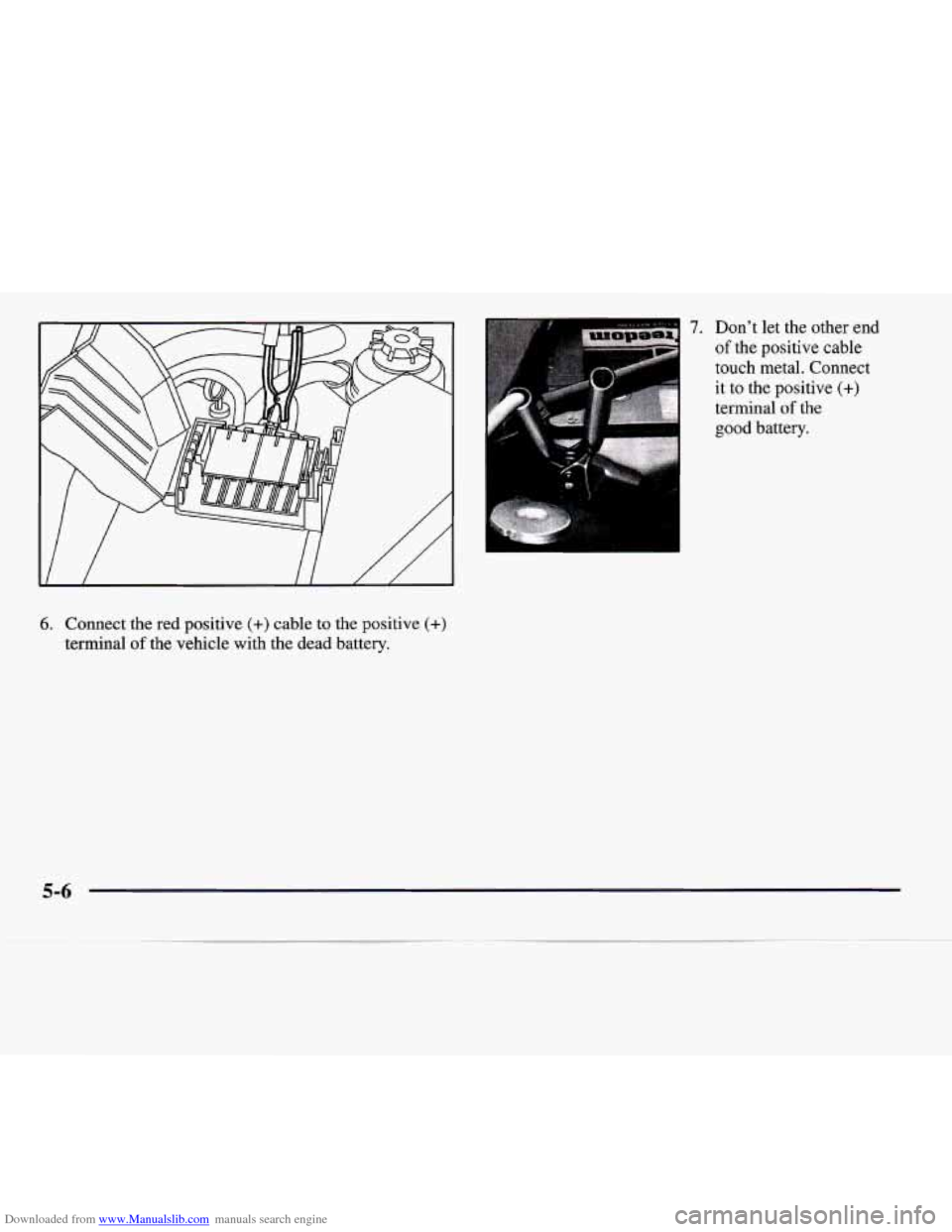
Downloaded from www.Manualslib.com manuals search engine 6. Connect the red positive (+) cable to the positive (+)
terminal of the vehicle with the dead battery.
7. Don’t let the other end
of the positive cable
touch metal. Connect
it to the positive
(+)
terminal of the
good battery.
5-6
Page 214 of 338
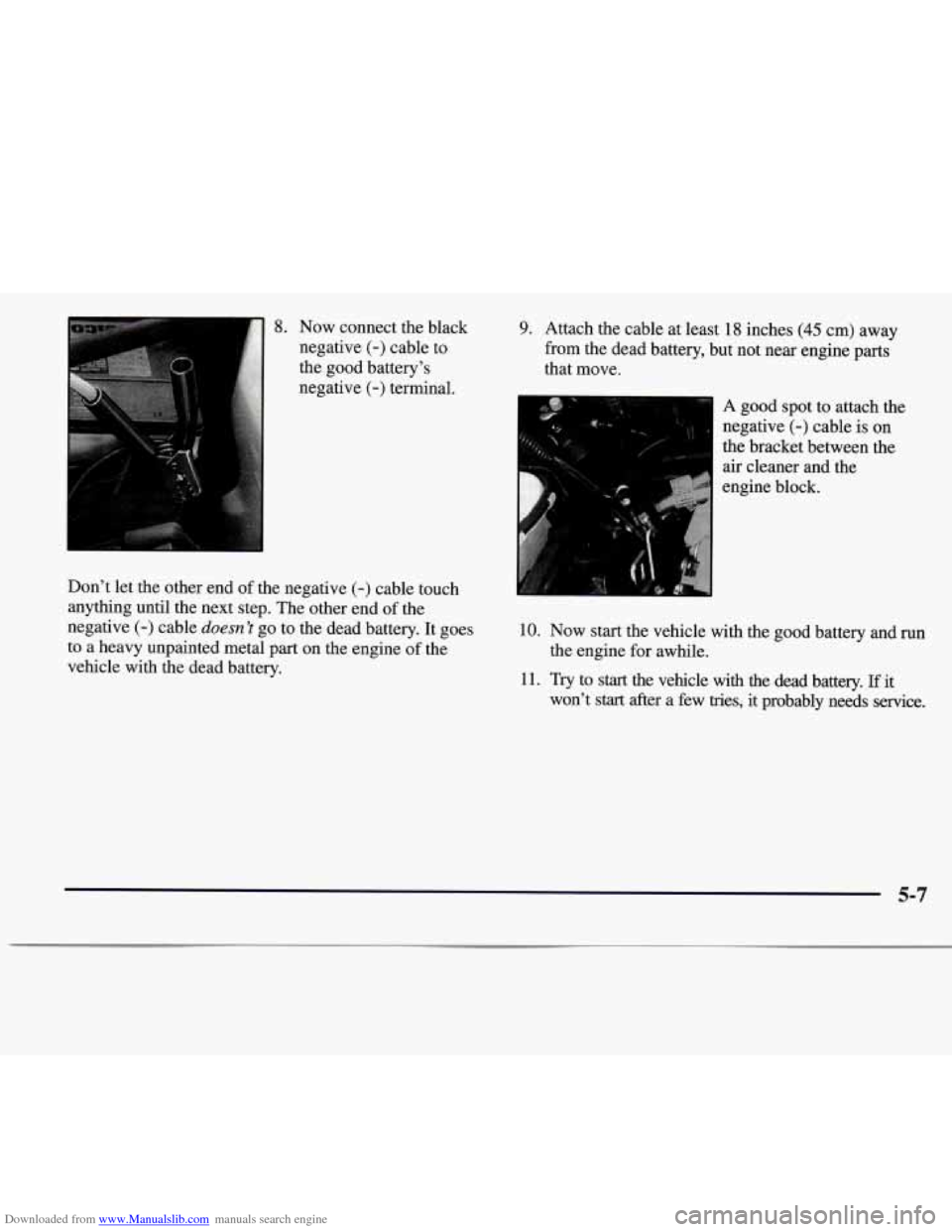
Downloaded from www.Manualslib.com manuals search engine 8. Now connect the black
negative
(-) cable to
the good battery’s
negative
(-) terminal.
Don’t let the other end of the negative
(-) cable touch
anything until the next step. The other end of the
negative
(-) cable doesn ’t go to the dead battery. It goes
to a heavy unpainted metal part on the engine of the
vehicle with the dead battery.
9. Attach the cable at least 18 inches (45 cm) away
from the dead battery, but not near engine parts
that move.
A good spot to attach the
negative
(-) cable is on
the bracket between
the
10. Now start the vehicle with the good battery and run
11. Try to start the vehicle with the dead battery. If it
the engine
for awhile.
won’t
start after a few tries, it probably needs service.
5-7
Page 215 of 338

Downloaded from www.Manualslib.com manuals search engine 12. Remove the cables in reverse order to prevent
electrical shorting. Take care that they don’t touch
each other or any other metal.
I- B +I
1
A. Heavy Metal Engine Part
B. Good Battery
C. Dead Battery
Towing Your Catera
Try to have a Catera dealer or a professional towing
service tow your Catera. See “Roadside Service”
in
the Index.
If your vehicle has been changed or modified since it
was factory-new by adding aftermarket items like fog
lamps, aero skirting or special tires and wheels, these
instructions may not be correct.
Before
you do anything, turn on the hazard
warning flashers.
When you call, tell the towing service:
That your vehicle has rear-wheel drive.
e The make, model and year of your vehicle.
e Whether you can still move the shift lever.
e If there was an accident, what was damaged.
When the towing service arrives, let the tow operator
know that this manual contains towing instructions and
illustrations. The operator may want to see them.
Page 328 of 338
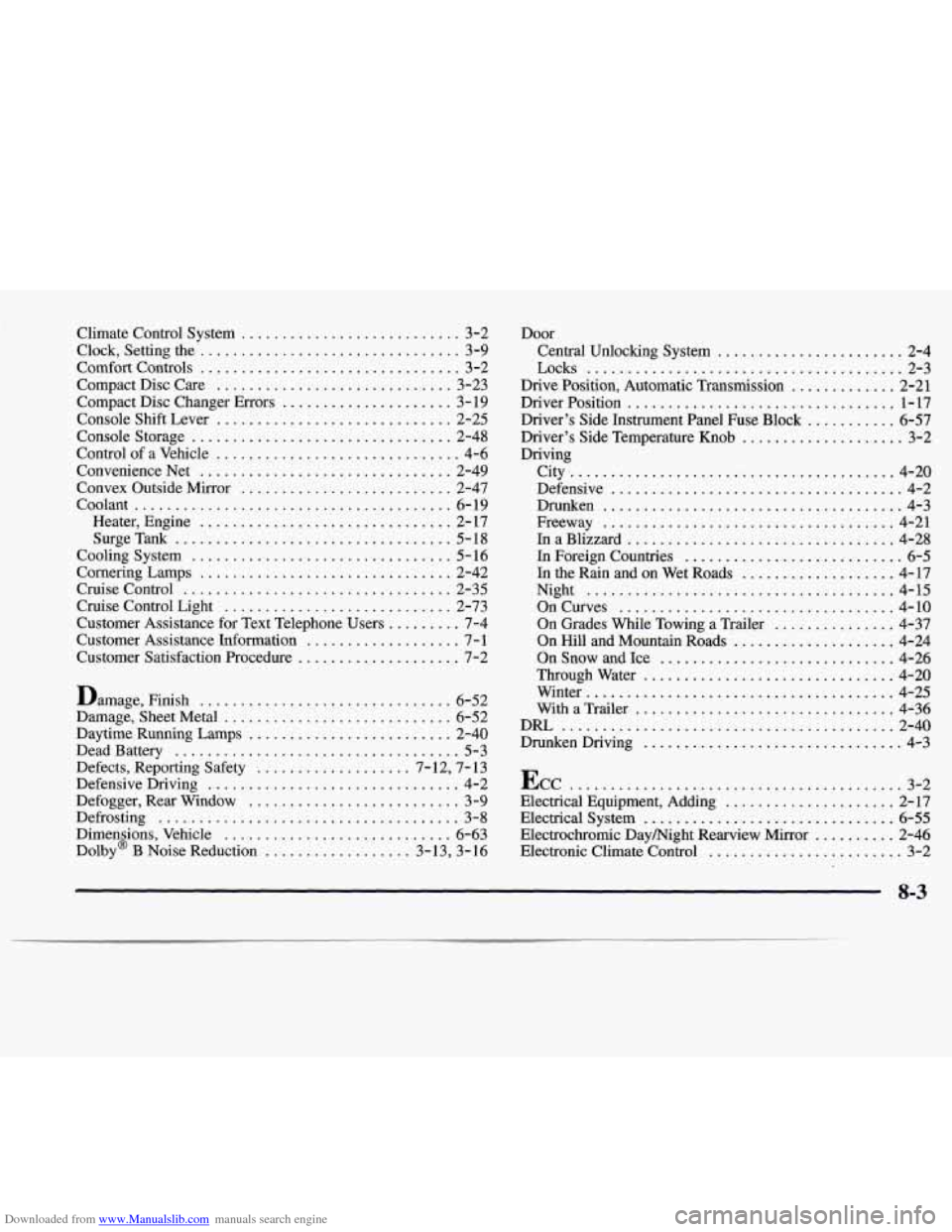
Downloaded from www.Manualslib.com manuals search engine Climate Control System ........................... 3-2
Comfort Controls
................................ 3-2
Compact Disc Care
............................. 3-23
Compact Disc Changer Errors
..................... 3- 19
Console Shift Lever
............................. 2-25
Console Storage
................................ 2-48
Control of a Vehicle
.............................. 4-6
Convenience Net
............................... 2-49
Convex Outside Mirror
.......................... 2-47
Coolant
....................................... 6-19
Heater. Engine
............................... 2-17
SurgeTank
.................................. 5-18
CoolingSystem
................................ 5-16
Cornering Lamps
............................... 2-42
Cruise Control
................................. 2-35
Cruise Control Light
............................ 2-73
Customer Assistance for Text Telephone Users
......... 7-4
Customer Assistance Information
................... 7-1
Customer Satisfaction Procedure
.................... 7-2
Clock. Setting the
................................ 3-9
Damage. Finish
............................... 6-52
Damage. Sheet Metal
............................ 6-52
Daytime Running Lamps
......................... 2-40
Dead Battery
................................... 5-3
Defects. Reporting Safety
................... 7- 12. 7. 13
Defensive Driving ............................... 4-2
Defogger. Rear Window
.......................... 3-9
Defrosting ..................................... 3-8
Dimensions. Vehicle
............................ 6-63
Dolby@
B Noise Reduction .................. 3-13. 3-16 Door
Central Unlocking System
....................... 2-4
Locks ....................................... 2-3
Drive Position. Automatic Transmission
............. 2-21
DriverPosition
................................. 1-17
Driver’s Side Instrument Panel
Fuse Block ........... 6-57
Driver’s Side Temperature
Knob .................... 3-2
Driving
City
........................................ 4-20
Defensive
.................................... 4-2
Drunken
..................................... 4-3
Freeway
.................................... 4-21
InaBlizzard
................................. 4-28
In Foreign Countries ........................... 6-5
In the Rain and on Wet Roads ................... 4-17
Night
...................................... 4-15
OnCurves
.................................. 4-10
On Grades While Towing a Trailer ............... 4-37
On Hill and Mountain Roads
.................... 4-24
On Snow and
Ice ............................. 4-26
Throughwater
............................... 4-20
Winter
...................................... 4-25
WithaTrailer
................................ 4-36
DrunkenDriving
................................ 4-3
ECC ......................................... 3-2
Electrical Equipment, Adding
..................... 2-17
Electrical System
............................... 6-55
Electronic Climate Control
........................ 3-2
DRL
......................................... 2-40
Electrochromic Daymight Rearview Mirror
.......... 2-46
8-3